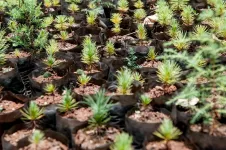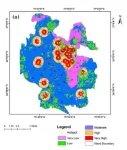Forest restoration action must prioritize diversity over scale for cheaper, long-term success
Researchers investigating the economic costs of forest restoration find that more up-front investment in tree diversity leads to greater long-term benefits
2021-03-26
(Press-News.org) Every year, 10 million hectares of forest are lost. Among efforts to revive degraded or deforested land is the Bonn Challenge, with a global goal to bring into restoration 350 million hectares by 2030. Yet such efforts neglect the nuanced but critical factor of bringing genetic diversity into restoration efforts for long-term success, which urgently needs to be addressed.
Integrating genetic diversity involves planting tree species with different genetic makeups and varied species adapted to local environments. If species are the same, they will not be able to reproduce or grow new seedlings. Christopher Kettle, an ecologist and geneticist at the Alliance of Bioversity International and the International Center for Tropical Agriculture (CIAT) explained:
"If 1,000 seeds are collected from two neighboring trees and planted in a nursery, those seeds would most likely be highly related. This would greatly reduce the probability that they would reproduce in a forest and produce new seeds. You're basically setting your restoration project up to fail from the start. That's one reason we need genetic diversity as a critical component of restoration projects."
New research in Frontiers in Forests and Global Change shows that investing effort in ensuring genetically diverse seedlings actually has the potential to decrease overall restoration costs by up to 11%. While ambitious goals like the Bonn Challenge have resulted in growing political national and international restoration commitments, planting high-value, fast-growing trees, like teak or eucalyptus, in large numbers can actually lower genetic diversity and undermine restoration efforts.
"There are enormous risks for tropical forests with low genetic diversity," said Kettle. "They will also have low capacity to adapt to the impacts of climate change; less resilience to new pests and pathogens. They will produce less seeds or fruit, with negative impacts on community livelihoods and income-generation. Investing in genetic diversity is the only sensible thing to do economically and ecologically, and it costs less in the long-run."
Danny Nef, an expert researching climate change and socio-economic changes at the Alliance and ETH Zurich, said that investing in genetic diversity is critical despite higher initial costs. "It would result in one third higher seed collection costs, but expected ecological and socioeconomic long-term benefits would far outweigh additional costs. Even without any positive effects on post-maintenance costs, the total cost of the overall project would only increase by around 1%," he said.
"Something that's amazed me while working on this paper is that not a single study I have found has considered genetic diversity in the cost of restoration. The question is why not? It simply doesn't make sense not to invest a little bit more at the start of restoration initiatives from a cost perspective, when you look at the bigger, holistic benefit."
Agricultural economist Elisabetta Gotor added: "We economists tend to measure income-related expenses because they are easiest to assess. But I think it's time for us to push ourselves, to tackle the resilience outcome generated by the conservation of genetics, looking at what materials are being used for example, for a more meaningful and accurate economic outcome from an environmental perspective."
The global benefits of tropical forest restoration may be harder to measure but "the costs of planting seedlings are often felt at one end of the scale by farmers for example, while the overall benefits occurring from restoration in the long-run are at the global scale," Gottor said. "This is why we have to connect the initial cost of investment in better quality seed, with the magnitude of broader benefits that don't necessary have a market value."
The researchers noted that while their evidence is based on a number of conservative assumptions and literature review, their findings show that long-term benefits associated with high genetic diversity are too low not to be considered and far outweigh costs. "This is an urgent call for restoration policies to integrate diversity at the species and genetic level into restoration planning and management," they said.
"We do not consider efficiency in this context to be the planting of as many trees as possible per invested capital, but rather the long-term establishment of a tree population that serves the aim of restoration and thus ensures the sustainability of the invested capital," they said, adding that building capacity among those responsible for implementing restoration efforts is also key to success.
INFORMATION:
[Attachments] See images for this press release:

ELSE PRESS RELEASES FROM THIS DATE:
2021-03-26
As COVID-19 vaccines slowly roll out across the world, government officials in densely populated countries must still manage vulnerable communities at highest risk of an outbreak.
In a new study published in the Journal Risk Analysis, researchers in India propose a COVID Risk Assessment and Mapping (CRAM) framework that results in a zoned map that officials can use to place more targeted restrictions on high-risk communities. Successfully used by officials in Jaipur at the peak of the pandemic last spring, their framework could help other vulnerable countries avoid a shutdown of their regional economies.
Led by Shruti Kanga, associate professor in the Centre for Climate Change and Water Research at Suresh ...
2021-03-26
An estimated 6 million Americans may suffer from peanut allergies. Tiny amounts of peanut protein can lead to hives, itching, tingling in the mouth, shortness of breath or nausea within minutes.
For individuals with severe peanut allergies, food-induced anaphylaxis can occur. It's a life-threatening emergency that requires treatment with an injection of epinephrine and a trip to the emergency room. Food labels offer warnings such as "may contain peanuts" or "was processed in a facility that may process nuts."
The warnings allow individuals with severe reactions to steer clear, but for consumers who may be able to tolerate a minimal amount of peanut protein without major incident the labels aren't very useful, says Lynne Haber, PhD, ...
2021-03-26
Women who suffer from vision, hearing or dual sensory loss are more than twice as likely to report depression and anxiety as men who experience the same issues, according to a new study by Anglia Ruskin University (ARU).
The research, which has been published in the International Journal of Geriatric Psychiatry, looked at survey data from more than 23,000 adults, where participants had self-reported whether they had suffered depression or anxiety, and also whether they experienced vision, hearing, or dual (both vision and hearing) sensory impairment.
Across the whole sample, the prevalence of depression ...
2021-03-26
So far, there has been little research into supportive care needs in patients with newly diagnosed incurable cancer and as their disease progresses. That is why experts from the German Cancer Society's working group on palliative medicine, led by Professor Florian Lordick, Director of the University Cancer Center Leipzig (UCCL), surveyed 500 patients between the ages of 25 and 89. What made the project special was the fact that the patients were accompanied from the moment they were diagnosed and before receiving any treatment. Professor Lordick sums it up thus: "There is an urgent need for patients to have early access to supportive palliative ...
2021-03-26
Usually, the different areas in the cerebrum take on a very specific function. For example, they process our movements or things we see or hear, i.e. direct physical information. However, some areas of the brain come into play when dealing with more advanced mental tasks. They process incoming information that has already been pre-processed and is thus already at an abstract level.
It was already known that the inferior parietal lobe (IPL) is one of these regions in the human brain. Nevertheless, it was unclear how this area is able to process such very different functions. In a large study, scientists from the Max Planck Institute for Human Cognitive and Brain Sciences (MPI CBS) in Leipzig and McGill ...
2021-03-26
During a normal waking state, information is processed and shared by various parts within our brain to enable flexible responses to external stimuli. Researchers from the University of Turku, Finland, found that during hypnosis the brain shifted to a state where individual brain regions acted more independently of each other.
"In a normal waking state, different brain regions share information with each other, but during hypnosis this process is kind of fractured and the various brain regions are no longer similarly synchronised," describes researcher Henry Railo from the Department of Clinical Neurophysiology at the University of Turku.
The finding shows that the brain may function quite differently ...
2021-03-26
Scientists at the University of Bonn and the caesar research center have isolated a molecule that might open new avenues in the fight against SARS coronavirus 2. The active ingredient binds to the spike protein that the virus uses to dock to the cells it infects. This prevents them from entering the respective cell, at least in the case of model viruses. It appears to do this by using a different mechanism than previously known inhibitors. The researchers therefore suspect that it may also help against viral mutations. The study will be published ...
2021-03-26
Researchers have demonstrated that stretching shape-memory polymers embedded with clusters of gold nanoparticles alters their plasmon-coupling, giving rise to desirable optical properties. One potential application for the material is a sensor that relies on optical properties to track an object or environment's thermal history.
At issue is a stretchable polymer embedded with gold nanospheres. If the material is heated and stretched, followed by cooling to room temperature, the material will hold its stretched shape indefinitely. Once reheated to 120 degrees Celsius, the material returns to its original shape.
But what's really interesting is that the gold nanospheres are not perfectly dispersed in the polymer. ...
2021-03-26
A recent study published in JCI found that a neutrophil's endoplasmic reticulum, the organelle that normally makes proteins in the cell, becomes stressed in the autoimmune disorder lupus. This stress activates a molecule called IRE1α, which appears to play a critical role in lupus pathogenesis in mice.
A multidisciplinary research group at the University of Michigan, spanning microbiology, dermatology and rheumatology, discovered that IRE1α orchestrates the release of neutrophil extracellular traps, or NETs, from lupus neutrophils. NETs are sticky, spider web-like structures that cause inflammation when released at the wrong time or in the ...
2021-03-26
Research has found that obesity and mental disorders such as depression and anxiety seem to often go hand in hand. Researchers at Baylor College of Medicine and collaborating institutions are providing new insights into this association by identifying and characterizing a novel neural circuit that mediates the reciprocal control of feeding and psychological states in mouse models.
Similar to human patients, mice that consumed a high-fat diet not only became obese, but also anxious and depressed, a condition mediated by a defective brain circuit. When the researchers genetically ...
LAST 30 PRESS RELEASES:
[Press-News.org] Forest restoration action must prioritize diversity over scale for cheaper, long-term success
Researchers investigating the economic costs of forest restoration find that more up-front investment in tree diversity leads to greater long-term benefits




